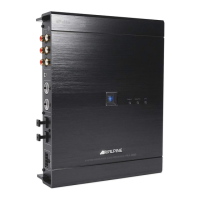
Do you have a question about the Alpine PXA-H800 Owner’s and is the answer not in the manual?
| Category | Car Stereo System |
|---|---|
| Model | PXA-H800 |
| Channels | 8 |
| Signal-to-Noise Ratio | 110 dB |
| DAC | 24-bit |
| Time Correction | Yes |
| Crossover | Yes |
| Type | Sound Processor |
| Outputs | 8 RCA |
| Frequency Response | 10Hz |
| Total Harmonic Distortion | 0.005% |
| Input Voltage | 11-16V DC |
| EQ Type | Parametric |
Guide on understanding manual structure and operation methods.
Identification of physical buttons, indicators, and connectors on the PXA-H800 unit.
Overview of the device's capabilities, including audio processing and connectivity.
Essential initial setup steps and installation of Sound Manager software.
Core operational procedures using the PC software.
Navigating menus and managing setup data files.
Method to load saved acoustic measurement data into the PXA-H800 unit.
Procedures for updating software and viewing version information.
Adjusting audio parameters and settings using the PC interface.
Precautions and preparation steps before running automated tuning.
Performing automatic acoustic calibration and managing settings.
Automatic optimization of speaker signal timing for accurate sound staging.
Automatic equalization adjustment based on ambient road noise.
Enabling or disabling the RoadEQ adaptive equalization feature.
Setting up Media Xpander Plus in Ai-NET or Standalone modes.
Selecting between Graphic EQ and Parametric EQ modes.
Adjusting sound frequencies using a multi-band graphic equalizer.
Fine-tuning sound with precise control over frequency, bandwidth, and gain.
Configuring crossover frequencies, slopes, and speaker phase settings.
Manually setting time delays for precise speaker signal alignment.
Selecting playback modes for stereo sources to enhance listening.
Applying EUPHONY surround sound technology for immersive audio.
Enabling and configuring Dolby Pro Logic II for surround sound.
Step-by-step guide for setting up multi-channel audio features.
Balancing speaker output levels using test tones for optimal sound.
Creating a virtual center channel for enhanced sound imaging.
Mixing rear and center low frequencies for enhanced bass response.
Configuring PCM output and powerful sound modes.
Setting volume levels for various digital audio formats.
Fundamental operations, system start-up, and power control.
Controlling subwoofer, volume, balance, fader, and defeat settings.
Switching input sources and storing/recalling custom settings.
Setting speaker systems, individual speakers, and subwoofer output.
Configuring AUX inputs, digital inputs, and navigation audio volume.
Overview of automated measurement functions via Commander.
Configuring MX Plus, Equalizer modes, Graphic EQ, Parametric EQ, and Crossovers.
Adjusting time correction and setting up multi-channel audio features.
Quickly muting audio and turning off display illumination.
Adjusting button illumination color and display brightness levels.
Selecting different display modes for the Commander unit.
Details on system configurations and input/output patterns.
Definitions of audio terms and technologies used in the manual.
Solutions for common problems encountered with the unit.
Detailed technical specifications for the PXA-H800 and RUX-C800.
Critical instructions regarding distraction, volume, and unit integrity.
Prohibitions against disassembly and keeping small parts from children.
Using the product in intended applications and halting use if issues arise.
Guidelines for cleaning, temperature, maintenance, and installation location.
